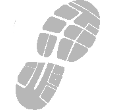-
North Bend,
Washington,
United States - August
- 26.2 miles/Marathon
- Trail Race
- Event Website
Scott Bland
McGregor, Texas, United StatesOverall
T-Shirts/SWAG
Aid Stations
Course Scenery
Expo Quality
Elevation Difficulty
Parking/Access
Race Management
First and foremost, I came into this race battling a Peroneal tendon issue that flared up again at mile 4 and essentially left me limp running by mile 21 and walking by mile 23. That has absolutely nothing to do with the race itself or the race directors and did not color my thoughts and impressions of this race.
The location of the race just east of the Seattle area is a beautiful trail made up of very compacted gravel and winds its way gently down a mountainous park area. The views are spectacular as you cross over many suspended bridges looking high over creeks and small water falls. The mountain tops just in the distance can't be seen for the clouds and mist that hang in the air around them.
As mentioned, the trail is compacted gravel, I never had a moment of losing my footing or having to dodge large rocks or roots. The race directors mention the advantage of wearing gators on your shoes, but I only had one instance of a rock getting in my shoe and having to stop to remove it. The downhill track is never overly steep and almost has no uphill at all, it's gentle enough to feel good but not have your quads ready to burst.
The name sake tunnel is a unique experience. Running in total darkness with only head lamps for light makes for a surreal experience of running in and amongst head lights that varied in brightness and range. Seeing the pin prick of light at the end of the tunnel slowly grow until you emerge on the other side is definitely an experience unique to this course. The organization on the other end of volunteers collecting your drop bag to return your head lamp to the finish line was well run and efficient as well.
Communication from the race directors leading up to race day is good, monthly emails with plenty of news and information. The location near Seattle is easy to get to and the race area is close enough to the city to be able to take in some sight seeing in Seattle the days before the race. I had no trouble getting an affordable hotel room or a rental car.
Unfortunately, the organization on the course was not on the same level. Since the water and aid stations were further apart than typical marathons, I carried a handheld water bottle with me for consistent hydration. This wound up being what saved me during the toughest miles of the race. At mile 15 I took nutrition and salt tabs using the remainder of my water knowing there was an aid station coming at mile 16 for a refill and sports drink to balance out all the water. For me, the miles from 14 to 20 tend to be the most mentally challenging as I've run almost to end of my glycogen stores but still have a lot of race left. Mile 20 is always a big boost for me, something mentally about hitting 20 and having only a 10K left always gives me a nice kick at the right time. So rounding the corner into Mile 16 and finding the water and aid station completely abandoned was the exact opposite of the kick I really needed. I initially panicked having just finished the remainder of my water. Fortunately, I was able to cobble together the remaining water out of several of the abandoned cans to be able to re-fill my bottle. Working with several other runners who were coming in behind me, we able to get ourselves hydrated enough to continue.
At this point, heading out of the abandoned water stop, I was mentally frazzled as well as dealing with the Peroneal issue. Out of concern for the unknown status of future water stops, I was overly conservative about drinking much from my bottle as I continued to run. Coming into Mile 18 confirmed the worst fears as that stop was also abandoned. Again, several of us cobbled together water from the cans left scattered on the ground, but there was no sports drink nor any medical personnel. I definitely had the though of what happens if someone gets seriously injured, we are literally in the middle of nowhere, no spectators, no race officials, no medical personnel.
As in Mile 16, I headed out from the Mile 18 abandoned stop concerned about my growing injury issue and the continued availability of fluids. Needless to say, this is not a good mental situation for a marathon. Thankfully, the Mile 21, and 24 station had 1 volunteer still there with sports drink at Mile 24 to break up the water, but by that point I was so mentally and physically out of the race it didn't make much difference.
I've never written a negative review for a race and hate to do so now, but I would absolutely not recommend this race. Until you run this trail, it's hard to appreciate how isolated it is. When the aid stations are abandoned I'm not sure how much you could depend on getting aid if something bad happened during the run. It was to the point where several of us were wondering if there had been some type of horrible incident in the Seattle area as the reason all the volunteers and medical personnel abandoned their stations. My injury issue caused my horrible performance, that is absolutely not on the race directors. However, there is no excuse for leaving so many of us on an isolated trail with no support for almost 10 miles (Mile 12 to Mile 21). There are several organizations that use this trail for marathons, I would suggest researching those groups and running the course with them.
Latest reviews













